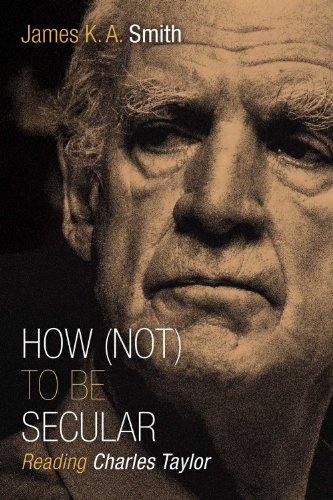Secularism is the air we breathe in contemporary Western society. It surrounds us and touches every endeavor, from our politics, to education, and even our churches. Its basic premise is that religious belief is appropriate only for our private lives, and inappropriate for public discourse. The state should not endorse it, our schools should not teach it, and our celebrities, should they reference it, should do so only in ways that do not remind us of the bigoted backward beliefs of pre-modern religions, like Christianity or Judaism. Secularism’s self-attested goal is to be religiously neutral, not endorsing one belief over another.
Beneath this veneer is the presumption that belief in God is nothing more than superstition, the presumption that transcendent reality—something beyond the material world we can measure and experience—does not actually exist. If it did exist, transcendence would certainly have implications for our public lives, our ethics, our social order. But popular consensus among the cultural elite is that it does not. However, relegation of religion to the private sphere is itself a statement of religious belief: that religion is inherently false.
 Exposing this hidden premise in contemporary secularism is the central aim of James K. A. Smith in How (Not) to be Secular. His book is actually “a book about a book.” That is, Smith’s book is a summary of philosopher and cultural critic Charles Taylor’s A Secular Age. Taylor’s work has been massively influential on Christian social thinkers, and Smith attempts to present an accessible rendition of his thought for the college or seminary student or thoughtful lay person.
Exposing this hidden premise in contemporary secularism is the central aim of James K. A. Smith in How (Not) to be Secular. His book is actually “a book about a book.” That is, Smith’s book is a summary of philosopher and cultural critic Charles Taylor’s A Secular Age. Taylor’s work has been massively influential on Christian social thinkers, and Smith attempts to present an accessible rendition of his thought for the college or seminary student or thoughtful lay person.
Taylor’s work explores the philosophical and ideological shifts since the Protestant Reformation which have produced Western secularism. But his study is not simply concerned with the emergence of new ideas. More basically, it explores how society’s thinking has changed to allow secularism to even be a live option—to be “imaginable.” Understanding how we got here, for Taylor, is less about arguments for materialism or Enlightenment critiques of orthodox Christian belief, and more about how society collectively thinks about the world.
Smith’s aim is to introduce us to Taylor’s thought and help us think clearly about secularism. He argues that understanding how we got here will help us see secularism for what it truly is. Seeing secularism for what it truly is—a type of religiosity without reference to God—helps Christians as we bump up against secularism in our vocations, politics, evangelism, or church planting.
Indeed, ours is a thoroughly secular age, with even Christians embracing basic presuppositions from the rise of secularism. There is no turning back to a pre-secular mindset, Smith argues with Taylor. The task now is to reopen our public and private lives to transcendence. By doing so, we show that no one can live consistently without reference to transcendence, try as they might.
According to Smith’s summary, the best way to understand Taylor’s argument is to trace secularism through a three-part evolution. The context for this is what Taylor calls the “social imaginary,” the collective assumptions and values which render particular beliefs as either live options or unimaginable. In the pre-modern era, if someone had professed disbelief in God, society would have judged this person to be insane. The world as they saw it was shot through with God’s presence and influence.
The Protestant Reformation in the 16th century, drawing on the influence of Augustine, gave rise to what Taylor calls Secular1. Shifts in belief about the nature of salvation, and by implication, the relation of the church to society, made it possible to see the church’s institutional role as concerned with matters related to the Gospel. This allowed for society to be brought out from under the direct authority of the church in other matters. Society comprises a separate arena of human life, which in this intermediate time between Christ’s ascension and his return is ordered by the populace and not the church. This was something new in the history of Western civilization.
The era of Secular2 emerged with technological advances which made it possible to affirm different beliefs about the material world and its origins. The telescope cast doubt on geocentric beliefs in favor of heliocentrism. Advances in communication, like the printing press, brought people in contact with different beliefs, giving rise to the recognition of a plurality of beliefs. This resulted in a quest to define human life in terms which everyone, despite their diverse beliefs, could affirm. Philosophically, early modern society sought a Cartesian “view from nowhere,” a view of truth without reference to religion. This led to similar endeavors in ethics, with Kant’s “categorical imperative,” and in political theory, with Rousseau’s “social contract” as the basis for state authority. Secular2 subsequently embraced a “subtraction theory” of religion, holding that what results if religion is taken out of the equation is still a well-functioning society. Thus, religious belief could be jettisoned from public discourse and relegated to the realm of private belief.
Secular3 is the logical outgrowth of Secular2, and the approach we are now left with. If Secular2 saw religion as irrelevant, Secular3 sees religion, and even the existence of a transcendent reality, as flat-out wrong at best, if not harmful. The era of Secular2 allowed Western society to construct an “immanent frame,” in which all of life is defined strictly in terms of immanent beliefs without reference to God. Secular3 now represents our attempt to live within this immanent frame.
Life within the immanent frame is fragile, Taylor says. When we cut ourselves off from the transcendent, we also cut ourselves off from ultimate meaning and purpose. Whereas before we received meaning from something beyond ourselves, we now have to create it for ourselves. We cannot live without meaning, so we are now haunted by it. We yearn for it, but because belief in God is unimaginable within our social imaginary, we are left to construct meaning on an individual basis, guided by only a feeling of transcendence. Our attempts to create meaning for ourselves ultimately bump up against one another and become “cross-pressured,” revealing themselves to be hollow and unable to bear the weight we place on them.
In this vortex of competing beliefs, Taylor says, even Christians live within the immanent frame. We subconsciously assume things about the world which make us more like the context around us than pre-modern society. The great strength of Christian belief, however, is that unlike our secular neighbors, we are still open to transcendence. At least in theory, our “take” on life, as Taylor says, is not closed to receiving universal truths from beyond the material world, truths which give life meaning and purpose.
Yet drawing on a positive feature of modernity, Taylor cautions us that human perspectives are no substitute for true certainty. It is one thing for someone to say he or she believes God is real. It is another thing to prove that God is real in the way someone might prove that there are two apples in the basket. Those who equate their religious beliefs with this latter type of certainty are guilty of an epistemological swagger, a confidence that they have satisfactorily proved what is contested beyond all shadow of doubt. This Taylor calls “spin,” and it is no different he says from the approach of contemporary academics who say God is not real. Such a pronouncement is no more demonstrable by the modern criteria of truth than the pronouncement that God is real. Therefore, both are types of religious beliefs which on their own are no more persuasive than any other attempts at finding meaning and purpose in our late modernity.
Because we inhabit an immanent frame in which all claims of universal truth are viewed with skepticism, Taylor says that Christians must approach our faith by playing by the rules of our collective social imaginary. We must live in a way which reveals that the Christian take on life is the most persuasive answer to what we are all searching for. Christianity possesses strengths which all other purely immanent religious beliefs lack: a stable source of moral authority and confidence in the face of death. Thus, for Taylor Christianity presents the best option for dealing with the secular “malaise” which plagues Western culture. It is up to Christians to help our neighbors “feel” how compelling our faith actually is.
Taylor’s A Secular Age ranks among the most important recent diagnoses of what ails Western society. Others worth mentioning are Philipp Rieff’s My Life among the Deathworks, Augosto del Noce’s The Crisis of Modernity, and Steven D. Smith’s Pagans and Christians in the City. James K. A. Smith has given contemporary Christians an invaluable resource in rendering Taylor’s thought (more) accessible. Perhaps Taylor’s greatest contribution is to help us see that secularism is not accepting of all sorts of belief. Rather, it has decidedly and lethally closed itself off from transcendence. It is therefore a type of religious belief which must be weighed against the way Christian faith teaches us to live life.
With that said, Taylor’s prognosis, and by association Smith’s as well, should provoke caution among orthodox Christians. Taylor’s own brand of progressive Catholicism is not something orthodox Christians would readily embrace. His openness to new renditions of the faith comes through in two of his convictions: (1) the way we live out our faith should change according to our contemporary context, and (2) the beliefs we hold and the confidence with which we hold them should adapt as well. Smith would do well to caution his readers that Taylor’s faith informs his approach, but he does not. Smith’s introduction to Taylor’s thought lacks exactly what the book’s title seems to promise: how are Christians to embrace Taylor’s argument without being secularist? Especially since Taylor says we are all in some way secularists now.
Still, this book is a must-read for all who seek to make sense of our contemporary cultural moment and love our neighbors in the midst of it.
Dennis Greeson is the associate director of the BibleMesh Institute and a PhD candidate in systematic theology at Southeastern Baptist Theological Seminary. He lives with his wife and two children in Nashville, Tennessee.
